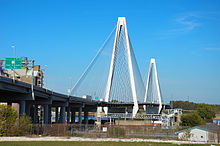Stan Musial Veterans Memorial Bridge
| Stan Musial Veterans Memorial Bridge | |
|---|---|

Stan Musial Veterans Memorial Bridge as seen from the Big Mound.
|
|
| Coordinates | 38°38′40″N 90°10′42″W / 38.64444°N 90.17833°W |
| Carries | 4 lanes of |
| Crosses | Mississippi River |
| Locale | St. Louis, Missouri and St. Clair County, Illinois |
| Official name | Stan Musial Veterans Memorial Bridge |
| Maintained by | MoDOT and IDOT |
| Characteristics | |
| Design | Cable-stayed bridge |
| Total length | 2,803 feet (854 m) |
| Width | 102 feet (31 m) |
| Longest span | 1,500 feet (457 m) |
| Clearance below | 75 feet (23 m) |
| History | |
| Designer | HNTB Corporation |
| Construction cost | $695 mil. |
| Inaugurated | February 8, 2014 |
| Opened | February 9, 2014 12:00 p.m. |
| Statistics | |
| Daily traffic | 31,000 cars and trucks |
The Stan Musial Veterans Memorial Bridge (known as the New Mississippi River Bridge until its formal naming in 2013 and informally known as the "Stan Span") is a bridge across the Mississippi River between St. Clair County, Illinois, and the city of St. Louis, Missouri. Built between April 19, 2010, and July 2013, the bridge opened on February 9, 2014. The cable-stayed bridge has a main span of 1,500 feet (457 m).
The main span of the bridge is 1,500 feet (460 m) in length, part of a total span of 2,803 feet. It is 86 feet (26 m) wide. Cables stretch from the bridge deck to the tops of two A-shaped towers, which reach 435 feet (133 m) above I-70. The new bridge's main span is supported by 1,000 miles (1,600 km) of 0.6-inch-diameter (15 mm) stay-cable strand, enough for nearly two round trips from St. Louis to Chicago. Nearly 15,000 tons of structural steel are used, along with 8,600 tons of reinforcing steel. Some 90,600 cubic yards of concrete are in the foundation, deck slab, and towers. At its completion, the bridge was the third-longest cable-stayed bridge in the United States.
The bridge was built to relieve traffic on nearby bridges, and to expand with traffic in the future. It carries four mainline traffic lanes, half as many as originally planned, with room to add a lane in each direction. It is designed so that a companion bridge could be built beside it. Initially, the new bridge was intended to reduce traffic by 20% on the Poplar Street Bridge, which carries I-55, I-64, I-70, and US 40; and 50% on the Martin Luther King Bridge.
After three months of use, it was estimated that 31,000 cars and trucks cross the bridge every day, about 10,000 less than the expected 40,000. Traffic volume on the nearby McKinley Bridge has not changed. The MLK Bridge traffic is down 44%. The Eads Bridge is down 3,000 cars per day, a 27% decrease compared to 2013. The Poplar Street Bridge, the busiest in the area, has had volume reduced by 20,000 cars per day, a 19% decrease.
...
Wikipedia
